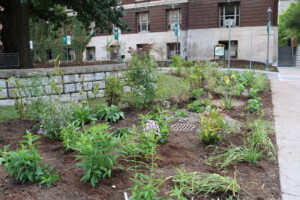A new garden planted around the iconic Robin Hood Oak is not just for showing off flowers. The garden near Bray Hall is filled with late-blooming plants native to Central New York and is part of ESF’s efforts in the Bee Campus USA program, a coalition of schools creating more native pollinator habitats and reducing pesticide use.
A primary component of Bee Campus USA is the installation of pollinator habitats using native plants to provide forage, nesting sites, and shelter from disturbance for many of the more than 400 species of bees native to New York, along with hundreds of other species of pollinating flies, wasps, butterflies and moths, and hummingbirds.

Pollinator garden planting event
From left to right: Ian Davis, Jeff Demperio, Luis Suatoni, Brett Schumacher, Shane Wehr, Molly Jacobson, Mike Vargason, Susan Fassler (Director of Sustainable Operations, ESF)
“We have nearly 450 different species of bees here in New York State as well as hundreds of other pollinator species and most of those require native plants to survive,” says Molly Jacobson ‘21, pollinator ecologist for ESF’s Restoration Science Center and co-chair of the College’s Bee Campus.
“In suburbia, or in urban environments, usually, it’s a lot of non-native plants,” Jacobson said. “There’s just not a lot of resources in general, or there might be a lot of pesticide use. So, there’s not really a lot of safe habitats for them and that makes it hard for them to survive.”
Jacobson said building more of these gardens encourages pollinators to come to the area.
“Creating more habitat patches like this, even if they’re small, is really going to support more native pollinators because the more patches that we create, the more connected they become, and then you’ve got before you know it, a whole swap of habitat that spans throughout a whole city and that can support all different kinds of species,” Jacobson said.
She adds that making the environment more friendly to bees and other insects will positively impact the food chain, providing more food for birds. Jacobson invited homeowners to think about growing a native garden on their property and says it’s relatively low maintenance to do so.
“It’s really easy to plant them and take care of them,” Jacobson said. “They’re more drought resistant so they provide you with better erosion control. They don’t need pesticides on them, they don’t need fertilizers, and they’re more adapted to the cold.”

Located near the campus’ historic Robin Hood Oak tree, some students are already using the garden for class. This is the first major planting on campus but it won’t be the only one. Another, much larger one, will be planted this spring right across from the Dome.
Check out the step-by-step guide on how to turn your yard into a native garden or meadow.


